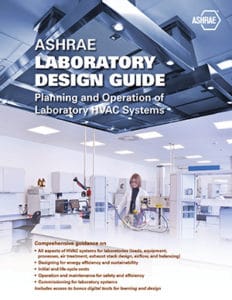ASHRAE Laboratory Design Guide : Planning and Operation of Laboratory HVAC Systems 2nd Edition
ASHRAE Laboratory Design Guide Planning and Operation of Laboratory HVAC Systems 2nd Edition
ASHRAE Laboratory Design Guide : Planning and Operation of Laboratory HVAC Systems 2nd Edition is a comprehensive reference manual for the planning, design, and operation of laboratories. It gives engineers, owners, and system operators the design and control strategies they need to reduce the laboratory’s energy footprint while ensuring safety, providing good comfort and indoor air quality, and protecting the integrity of laboratory experiments.
ASHRAE Laboratory Design Guide is organized around a typical project, progressing through the basic steps of planning, design, construction, and operation and maintenance. It offers basic background information on laboratories, including their various types and the typical equipment found in them, to provide a basic understanding of laboratories and their importance as well as their different functions and needs.
You can also Read ASHRAE Design Guide For Dedicated Outdoor Air Systems – DOAS 2017
The book covers topics such as exhaust hoods, primary air systems, process cooling, air treatment, exhaust stack design, airflow patterns and system balancing, energy recovery, the laboratory commissioning process, and the economics of both initial and life-cycle costs.
A dedicated chapter gives guidance on laboratories that specialize in biological containment and animal research, addressing envelope design, system reliability, redundancy, proper space pressurization, biohazard containment and control, product protection, and also sanitation.
ASHRAE Laboratory Design Guide : Planning and Operation of Laboratory HVAC Systems 2nd Edition
- Paperback: 328 pages
![ASHRAE Laboratory Design Guide ASHRAE Laboratory Design Guide, ASHRAE Laboratory,ASHRAE,laboratory, laboratories, laboratory hvac, fume hood, biological safety cabinet, biological containment, animal research]()
- Publisher: Ashrae; 2 edition
- Language: English
- ISBN-10: 1936504987
- ISBN-13: 978-1936504985
- Product Dimensions: 8.5 x 0.8 x 10.5 inches
- Shipping Weight: 12.6 ounces
Updated to reflect current standards and industry practices, this second edition also adds two new chapters: one on high-performance building design concepts for sustainability and one with guidelines on evaluating airflow patterns and contaminant concentrations using computational fluid dynamics (CFD) computer modeling.
Finally, included with this Guide expanded web links to industry standards and resources as well as design tools that help illustrate the features of laboratories and provide practical aids for design.


Comments are closed.